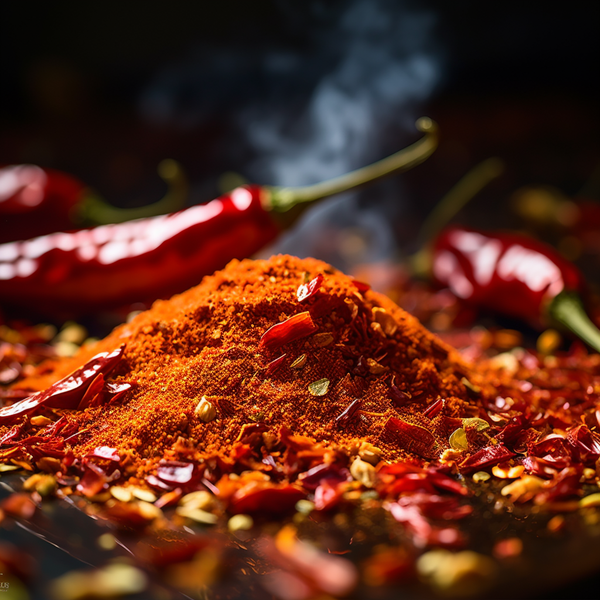
Cayenne Pepper: A Hot Topic in Health and Cuisine
Introduction to Cayenne Pepper
Cayenne pepper, an all-time favorite spice, adds not just heat, but also a multitude of health benefits to our dishes. But have you ever wondered about the origin of this versatile ingredient?

Origin and History of Cayenne Pepper
Cayenne pepper hails from Central and South America, with a history of use spanning thousands of years. Today, its cultivation and use has spread globally, making it an integral part of many cuisines.

Types of Cayenne Pepper
There are several types of cayenne peppers, ranging in heat levels measured on the Scoville scale. From the mild heat of the Purple Cayenne to the fiery punch of the Golden Cayenne, there's a variety to suit every palate.

The Health Benefits of Cayenne Pepper
From culinary delights to alternative medicine, the cayenne pepper, a fiery chili, has permeated multiple facets of human life. But what’s the secret behind its fame? The answer lies in a potent compound known as capsaicin. This miraculous element is the powerhouse that fuels the numerous health benefits associated with cayenne pepper.

Capsaicin: The Mighty Pain Reliever
Capsaicin is indeed a paradox, don't you think? The very same component that gives cayenne pepper its fiery heat is also the secret behind its potent pain-relieving properties. Akin to a benevolent fire elemental from folklore, capsaicin imparts warmth and healing, soothing various forms of pain in its path. But how does it achieve this feat? Let's embark on a journey into the world of biochemistry and explore.

The Science of Capsaicin: How it Works
Our body communicates pain through a complex network of nerve endings. When you hurt your finger or scorch your tongue, your body responds by releasing a neuropeptide known as substance P. Substance P is like a tiny postman who delivers 'pain letters' to your brain. This postal service of sorts helps the brain register the intensity and location of your pain.
Here's where capsaicin comes into play. Capsaicin plays a rather devious trick on these tiny postmen. When you consume or apply cayenne pepper, the capsaicin interacts with the nerve endings and blocks the release of substance P. By doing so, it prevents these 'pain letters' from reaching your brain. Consequently, your brain remains blissfully unaware of the pain, leading to a decrease in discomfort.
Isn't it incredible how capsaicin plays this elaborate game of 'hide and seek' with our pain sensations?

The Healing Features of Capsaicin
The healing properties of capsaicin aren't limited to pain relief alone. A variety of studies have revealed its potential in promoting wound healing. The mechanism here involves the very same substance P we've been discussing. Substance P, apart from being a pain courier, also plays a crucial role in the inflammation process that aids in wound healing.
When you get a cut or wound, substance P is one of the first responders at the scene, triggering an inflammatory response that summons white blood cells to the site of injury. These white blood cells ward off any potential infections, thus ensuring that the healing process proceeds without a hitch.
By consuming cayenne pepper, you're essentially facilitating this healing process. The capsaicin ensures an ample release of substance P at the site of the wound, aiding in a quicker and more efficient healing response.

Cayenne Pepper: Your Digestive Aid
Unbeknownst to many, cayenne pepper, a humble spice in our kitchens, doubles as a robust digestive aid. Think of it as your personal culinary companion, stepping up to transform your internal digestive processes, much like how a furnace refines raw ore into precious metal!

Capsaicin: The Digestive Dynamo
But how does cayenne pepper do this? Once again, we owe a debt of gratitude to our fiery friend capsaicin. When cayenne pepper is consumed, capsaicin comes into contact with your digestive system and works its magic. Imagine it as a maestro, conducting a symphony within your digestive tract. It encourages the production of digestive enzymes, these diligent workers that break down the food you eat into smaller, absorbable nutrients.
Simultaneously, capsaicin also stimulates the secretion of gastric juices – your stomach's natural elixir that aids in digestion. With increased gastric juice flow, your body is better equipped to metabolize the food you ingest and expel any unwelcome toxins.
By aiding in the digestion process, capsaicin ensures that the nutrients from your food are effectively absorbed, contributing to overall health and wellbeing.
Cayenne Pepper for Weight Loss: A Natural Metabolism Booster
In your quest for a healthier, more energetic lifestyle, imagine discovering a natural ally. A companion that not only spices up your meals but also fuels your metabolic fire. This vibrant ally could be as close as your kitchen cupboard, lying in wait among your spices - the hot cayenne pepper.

Organic Cayenne Pepper: The Metabolic Maestro
So, what makes the organic cayenne pepper such a potent metabolism booster? The answer is our fiery friend, capsaicin. Like a skilled conductor leading a metabolic symphony, capsaicin triggers a lively performance within your body.
Once the cayenne spice makes its entrance into your system, capsaicin springs into action. It ignites your body's furnace, leading to an increase in the amount of heat your body produces. This thermal boost is not just about warmth, but energy, resulting in an elevated calorie burn. This process is known in the scientific world as diet-induced thermogenesis.
Diet-induced thermogenesis essentially accelerates your metabolic rate, which is the pace at which your body burns calories. By adding cayenne chilli to your meals, you're offering your metabolism a powerful kickstart, paving the way for an enhanced calorie burn.
So, the next time you're looking to give your weight loss journey a natural boost, consider reaching for the cayenne spice. The fiery kick of hot cayenne pepper does more than tantalise your taste buds; it could be the secret ingredient to ignite your body's full metabolic potential! Remember, when it comes to boosting your metabolism, the cayenne chilli is much more than a spice - it's a dietary game-changer!

🌶️Capsaicin Meter: A Guide to Peppery Heat
Let's journey through the Scoville scale and dive into the world of peppers. Buckle up for this spicy ride!
-
Mild (0 - 15,000 SHU) 🟢
- Bell Peppers: A zero on the Scoville scale, but a hundred in versatility. Perfect for salads, stir-fries, and stuffing!
- Banana Peppers: With a hint of sweetness, they're a wonderful addition to sandwiches and pizzas.
-
Medium (15,001 - 350,000 SHU) 🟡
- Jalapeños: A household name! Their bright, savory flavor and a tinge of heat make them perfect for salsas, guacamole, and poppers.
- Cayenne Pepper: A fiery friend in our kitchens, known for its medicinal and culinary wonders, is a favorite in hot sauces.
-
Hot (350,001 - 1,000,000 SHU) 🟠
- Habaneros: A tropical delight with a fiery punch, they are a must in Caribbean cuisine.
- Scotch Bonnets: Meet the Habanero's cousin! They share a similar heat profile and are essential in Jamaican Jerk recipes.
-
Very Hot (1,000,001 - 2,000,000 SHU) 🔴
- Ghost Peppers: Not for the faint-hearted! Their smoky flavor is a daring addition to chili and hot sauces.
- Trinidad Scorpion: Aptly named for its stinging heat, it's second only to our next, extremely hot contender.
-
Extremely Hot (Above 2,000,000 SHU) 🔥
- Carolina Reaper: Crowned the hottest pepper by the Guinness World Records, it’s an absolute blaze. Caution advised!
Remember, it's not just about the heat, it's about the flavor dance on your palate. Whether you're a heat-seeker or prefer a mild, flavorful melody, there's a pepper for you. Use this guide to find your perfect pepper match, and let's keep the culinary adventure sizzling! 🌶️🔥

FAQ's
Q1: Where does the cayenne pepper originally come from?
Cayenne pepper originates from Central and South America, with a history of use spanning thousands of years. Today, it's cultivated and used worldwide.
Q2: How does capsaicin, the active compound in cayenne pepper, relieve pain?
Capsaicin, found in cayenne pepper, blocks the release of 'substance P,' a neuropeptide that our body uses to communicate pain signals to the brain. Thus, it reduces the perception of pain, leading to a decrease in discomfort.
Q3: Can cayenne pepper assist in wound healing? How?
Yes, it can. Capsaicin facilitates the release of 'substance P,' which triggers an inflammatory response attracting white blood cells to the injury site. This process wards off infections, ensuring a smooth healing process.
Q4: How does cayenne pepper aid in digestion?
Cayenne pepper enhances digestion by stimulating the production of digestive enzymes and gastric juices, both essential for breaking down food and enhancing nutrient absorption. The key player in this process is capsaicin, the compound that gives cayenne its heat.
Q5: How can cayenne pepper help with weight loss?
Cayenne pepper, thanks to capsaicin, can boost your metabolism by triggering a process called diet-induced thermogenesis. This process raises your body's heat production and energy expenditure, leading to an elevated calorie burn, which can support weight loss efforts.
A Friendly Note to Our Readers
While we strive to enlighten you with the potential benefits of cayenne pepper, we want to ensure that you understand this information is intended as a guide and a source of inspiration. Our content is not designed to replace professional medical advice or treatment.
The effects of cayenne pepper and its constituent, capsaicin, can vary from person to person. Just like our taste in spices, our bodies are unique. What works wonderfully for one might not produce the same results for another. So, if you're considering integrating cayenne pepper into your diet or lifestyle, we highly recommend consulting with a healthcare professional first.

Leave a comment